by Liam Cook
October 24, 2023
0

With more complex link algorithms being released in what seems like every month, now more than ever it’s imperative to be building high-quality links. Everyone has their own idea of what makes a good link from the extreme wallpaper site owner who only gets links from sites devoted to wallpaper to the pharmacy collecting links from a site talking about anything from painting fences to performing heart surgery because because they have “1k+ Ahref traffic and a DA of 50 or more”.
So what is the best strategy and what will stand the test of time against Google’s relentless updates? About something in between but it’s a little bit more complicated than that.
While Digital PR is great for acquiring high-quality links that are otherwise unattainable through standard guest posting, the result for the most part is still effectively the same as a guest post and it is not going to protect you from algorithm punishments. It’s great for link diversity and building on an already strong foundation of a site. We talk about a site below which had some of the best PR links In the game and was still hit by an update.
Let’s open by saying Domain Authority and Domain Rating are arbitrary numbers, anyone can artificially inflate these figures just because it’s a DR70+ doesn’t mean your site is going to the moon. That’s also not to say it’s not a good indication of a site’s strength, so let’s explore. Let’s classify sites as high, mid and low quality with some examples:
Reader’s Digest is known by every SEO and his dog for selling links. Whilst this is a red flag in some cases, they post a lot of content without links including news articles. The site is a lifestyle, health, and travel news blog and it’s its content is true to its niche.
Things that make Readers Digest a good site:
Besides the giveaway wordart style title and the existence of both a travel and business category which are red flags in themselves, this site just gives a feel of not being legitimate. Notably the domain is much older than its traffic shown by the blue and orange lines, meaning it’s been revived or repurposed.
Things that make this an okay site:
This site is a perfect example in the sense that it has great metrics, intelligible keywords and consistent traffic. The thing that makes it perfect besides the dating category is all of the central posts are about digital marketing and tech. The giveaway is in the sidebar and the keywords.
Things that make this a bad site:
Now there’s nothing to say a mid-quality site or even a low-quality site won’t move the needle in some way or another. It’s also not to say you should avoid mid-quality if the price is right and your content strategy is strong (we’ll come to this later). However, you should absolutely avoid low-quality sites as these provide next to no value and in our database the few that we keep a record of more often than not go to zero traffic in time. In addition, also don’t have any topical authority other than the spammy keywords they rank for. The goal is to find a site with some authority in one top-level category that your site fits into which brings us to our next point, relevance.
This is one people take to absolute extremes in which a woodworker demands links from woodworking blogs, while it makes sense, I highly doubt there are many high-authority blogs in this niche willing to link. The best way to decide whether a site is relevant is to ask does my anchor and title relate to a top-level category of the website.
For example, if you’re providing wardrobes for the public, sites with a home category, sites in the home niche or a general country-specific (e.g. news) site is perfect. It’s great to have as much variety in the niches too, for example, if such a wardrobe client started with us in the UK, we’d build around half the links from home sites and the other half from UK news/general. If you had only contextual links from home-related sites it doesn’t look entirely natural and makes for poor link diversity, more on this later.
Depending on how big your link budget is you’re eventually going to find yourself running out of the creme of the crop sites and edging into the mid-level quality. However, provided you stick to the rule ‘Does my article make sense on this site and is this site of mid or above quality?’ You’ll see some gains in the search results.
What has content output got to do with link building? Best to start with a bit of history! Google, in the past, targeted those link-building by trying to classify what a ‘spammy’ link is and in the Penguin 2016 update they decimated sites which had a ton of high DA non-relevant questionable looking links. However, this gave way to negative SEO where anyone could send a ton of rough links to somebody you didn’t like and their site would tank.
In light of this Google moved to just ignore bad links instead of you needing to constantly be disavowing them, thanks SEO Jesus! However, Google needed a new approach and now this is purely just my theory on what I see but I’m sure others have come to the same or similar conclusions. Google is now using AI, almost like the spam bot on Tinder when you swiped too many rights and didn’t say hi. If your content output is relative to the velocity of links you are receiving, you will grow well even with mid-tier links. I believe that Google sees that your site is posting a lot, so it warrants the volume of links that you are getting. It also looks at how many links you have relative to how many posts you have and what the industry average is for this.
So this actually excludes e-commerce sites from having to post a lot of blogs, since the industry average number of pages will be quite low. Whereas a service provider for example an immigration law firm would have a high number of outputs due to the variety of visas and information needed. This doesn’t mean an ecommerce site shouldn’t post relevant guides and help, whilst also having great on page SEO, it just means I’ve not seen an e-commerce site tank through links (there are different metrics for ecom).
So if you are building 100 links a month to a low authority site with little content you better be posting 100-200 articles a month. If your site is already high authority and covers most keywords in your niche then you’re more than fine.
Not only this you also need to be updating your pages, adding internals and improving the overall site quality to provide the best experience possible to users. The sites we see do the best with links are the ones that give their site a lot of love and the ones that do the worst rely on links to do all the heavy lifting.
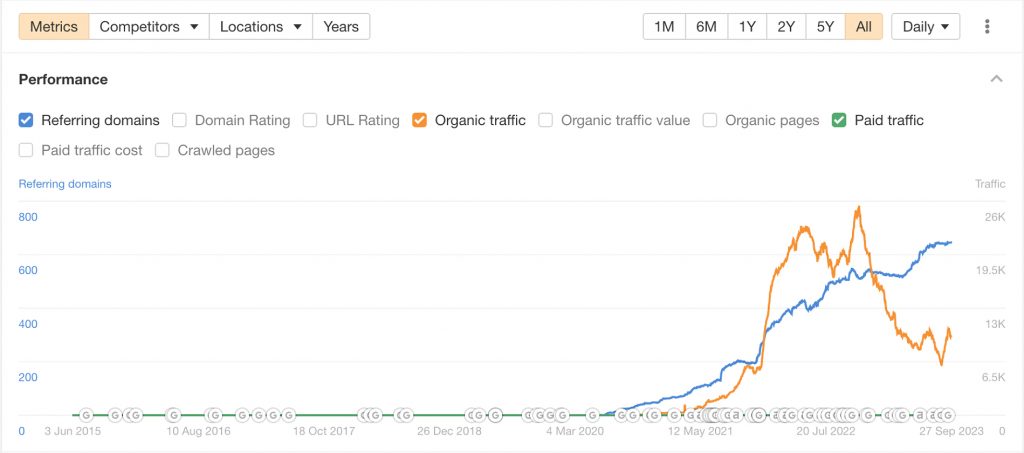
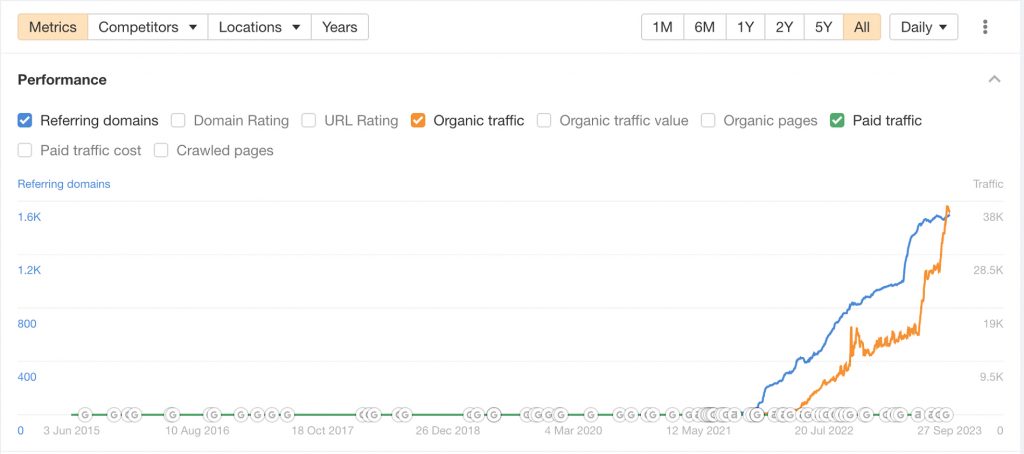
The only difference? The client was passionate about growing the site on the right, each site was getting 50 links a month but the left site was posting no new content and the right featured 100 new posts a month.
I mean it makes sense right, if a site only has 100 pages for what reason would it be getting 10x the links of a site with 1000 pages? Many people have also proposed the ‘topical authority strategy’ where you can rank purely just off content, I believe this feeds into that and builds on it.
Another example of a potential client just before they got hit by the December update:
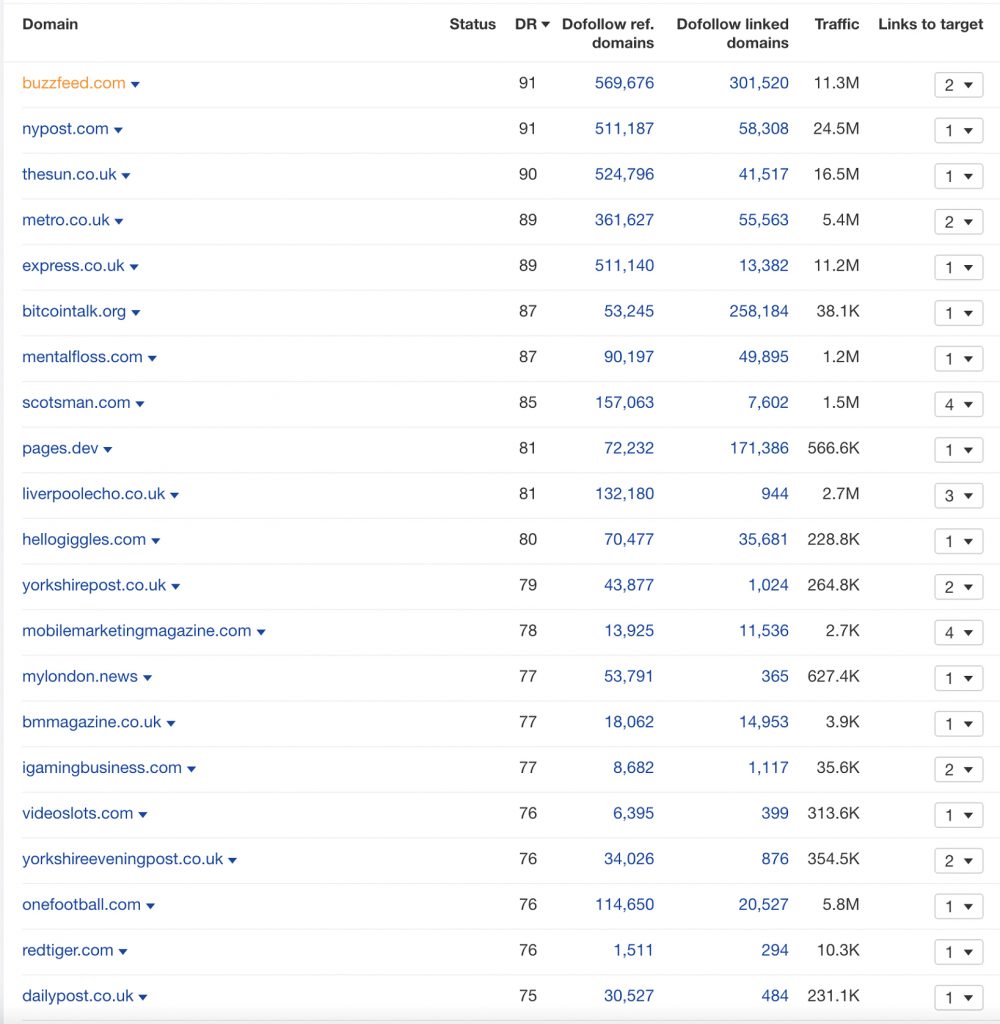
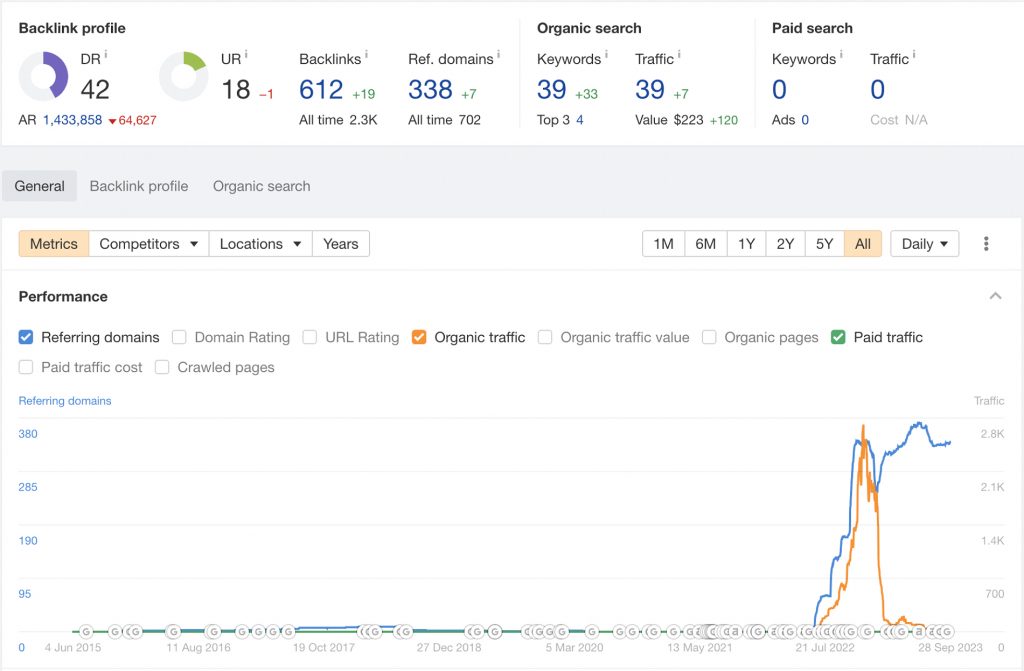
They were building some of the best quality links you can find, they just didn’t have enough diversity in their link profile and enough content output for their aggressive link-building to make sense. Should’ve saved money and just built mid-tier!
Also, If a site is not moving it’s going to need some on-page love as well as a link-building strategy. If a page is not moving no matter how many links you send it’s probably time to work on the on-site, links can’t do everything and you’re likely to do more damage than good if you keep building. We’re currently building links to an e-commerce that hasn’t seen any love in years and it’s not moving one bit.
Just as important as picking good sites to link from is understanding the value of the page you’re linking to and the competition you are against. If your main competitors have a few thousand more in content links than you and a far higher DR your £1k a month link budget will take you years to rank for the same terms and leave a nasty hole in your pocket. The topic of competitor link analysis has been covered by many blogs however these articles just suggest finding the links your competitors have which is good but doesn’t give enough insight on how much it’s going to cost and whether it’s possible.
To start with depending on where your site is currently ranking, identifying pages and longer tail keywords that are less competitive will help you get results in the short to medium term and in some cases achieve results at all. For example, we spoke to a mortgage broker who was looking for SEO link services but as you can imagine going after buy-to-let terms will require him to rob a bank. So what we did was discuss a budget of 10 links a month and then found some competitors which had around 100-300 more in-content links to give us a 1-3 year outlook. Suddenly we have a list of keywords that are within our remit to compete on:
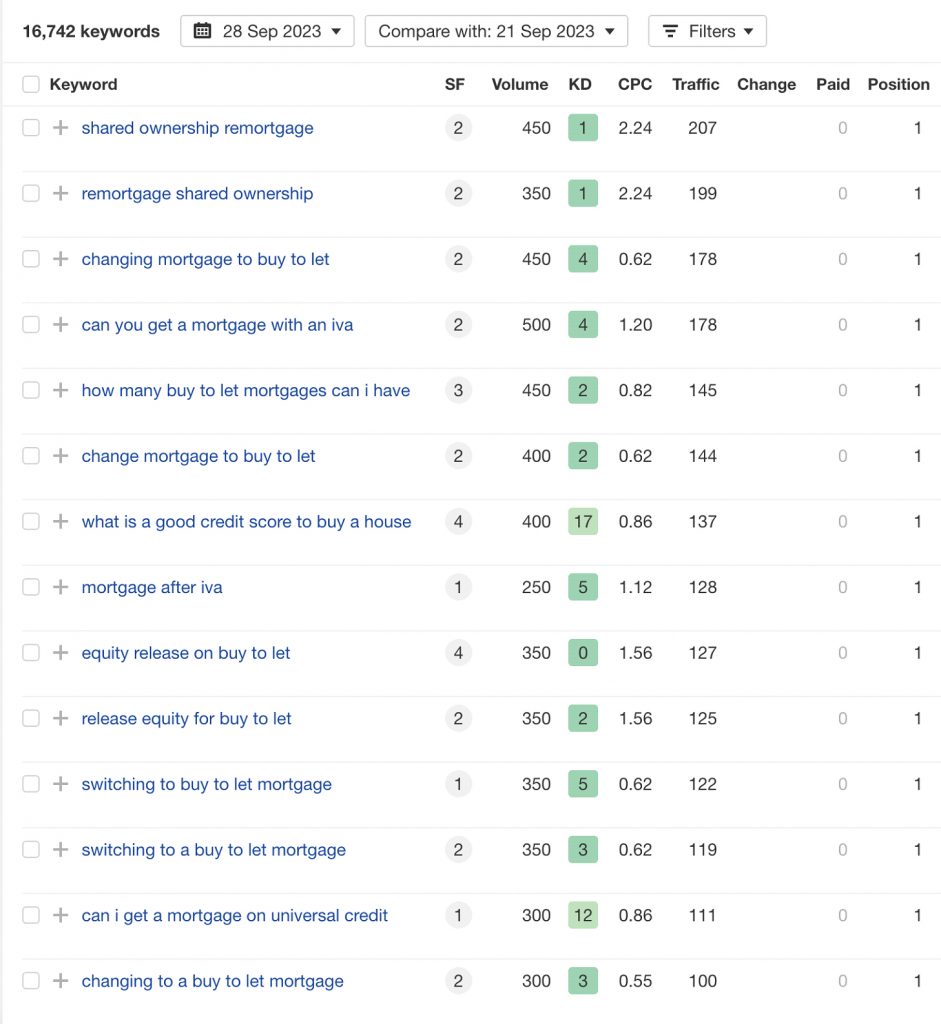
So if your site is already established it’s best not to get shiny object syndrome and go after that brand-new service you just released unless you understand that it’s going to take you quite some time to see a return on your link investment. It’s going to be a lot quicker to get from position 7 to 1 than from nowhere as Google already has some data on how your site performs with users. Notably depending on your authority the key things to look at are:
Most readers are probably familiar with proper anchor text so I won’t go into too much detail on this. If your site is low to medium authority and doesn’t have a lot of links, it’s best to do a 30/70% split of branded links to the homepage and to the internal pages respectively. Don’t go too heavy on one internal page to the point that it almost has as many links as your homepage.
Exact matches are fine so don’t fear, just make sure it’s one in every 10-15 anchors. Using Ahrefs is a great way to find a variety of anchors to use and if your page doesn’t rank yet, just put in a top-ranking page for the desired keyword. For example, the page below is set up for whisky investment, but just by putting it into Ahrefs, we see all the variations people are searching to get to the page which are all suitable anchors. Just make sure when featured in content the anchor makes sense, e.g. ‘the whisky investment UK’ should be ‘whisky investment
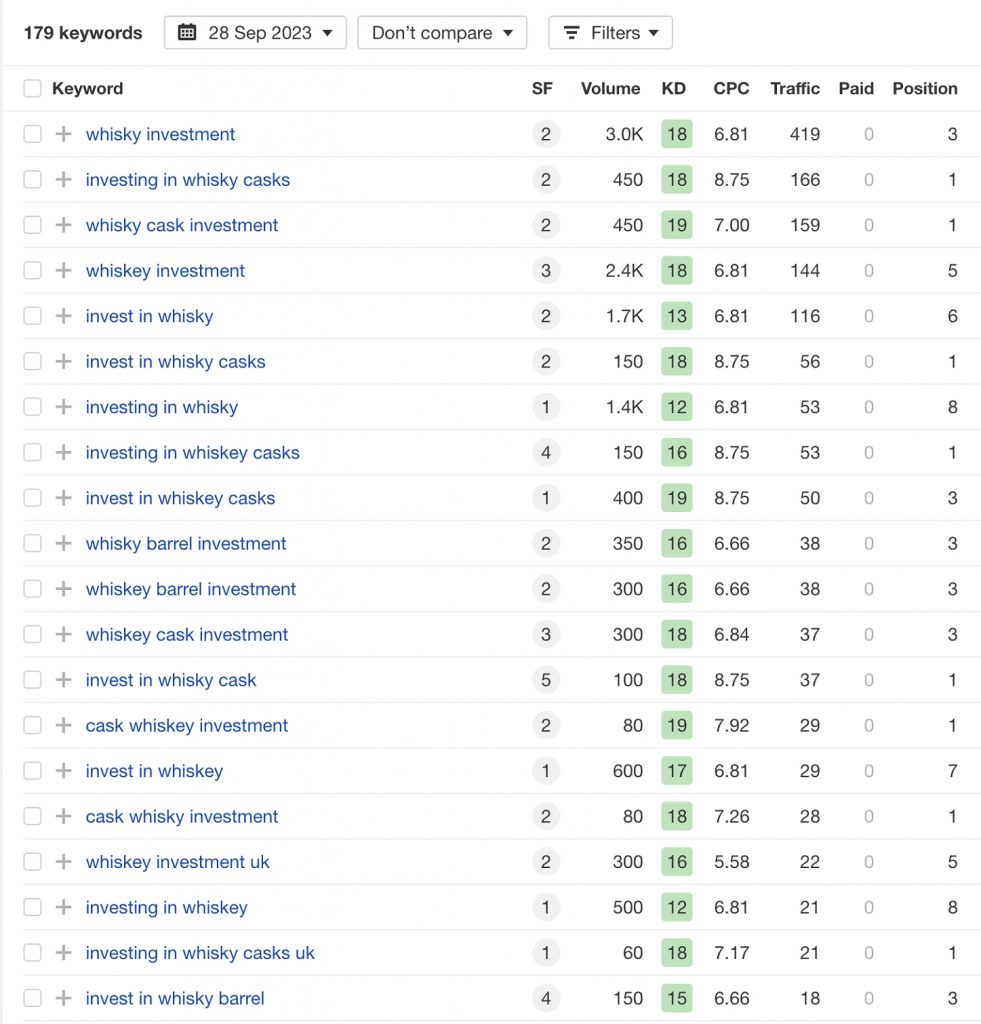
in the UK’ or ‘UK whisky investment’. Besides this, you can use filler words or mix the syntax if you run out of options, for example, ‘start investing in whisky’, ‘get started in investing in whisky’ and ‘whisky investment casks’.
Don’t be afraid to use keyword anchors provided you have a strong on-page strategy (yes I’m mentioning it again!). Particularly if you have a small budget, as if you are being super safe with anchors you’ll fail to help Google establish the purpose of your pages.
This brings me to a final point on anchors. If you have a page that is selling suits for example and a subcategory page of black suits, do not build anchors of ‘black suits’ to your suits page, keep it to the black suits page. Identify the keywords a page is for and ensure no crossover with other pages to prevent cannibalisation or the wrong pages from ranking.
This is actually a really big one now and also part of the reason I believe the potential client above was hit an update. Ensure you have links from many sources i.e. in-content, citations, forums, socials, and blogspot. PR comes under in content links even though you get some stellar links from big publications, it’s still in content. The site mentioned above had a 60% in content link profile, this is not a hard and fast rule but aim to keep it around 20-30%.


Many businesses now, even if they don’t have a physical location are opening Google My Business listings and are buying cheap citations to create good link diversity. Also, I’ve spoken to quite a few clients who are using GSA to build links in the background since all you need is a server to run it on. Forum links are a great way to diversify, perhaps someone asks a question on a forum and someone suggests your service or article as a response.
This is an online travel agent:

Don’t get bogged down with finding the absolute perfect sites so much so that you’re barely building any links. Link building is a part of a much bigger picture of what makes a good authority site, and we need to be more dynamic in our thinking of what makes for a good strategy. Give your site some love and Google will love it too.
